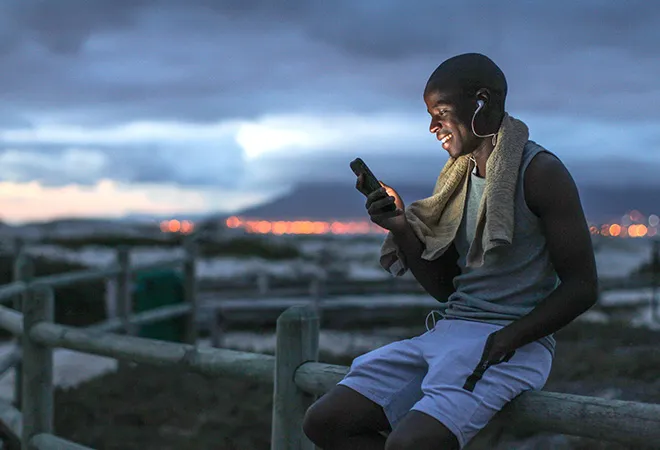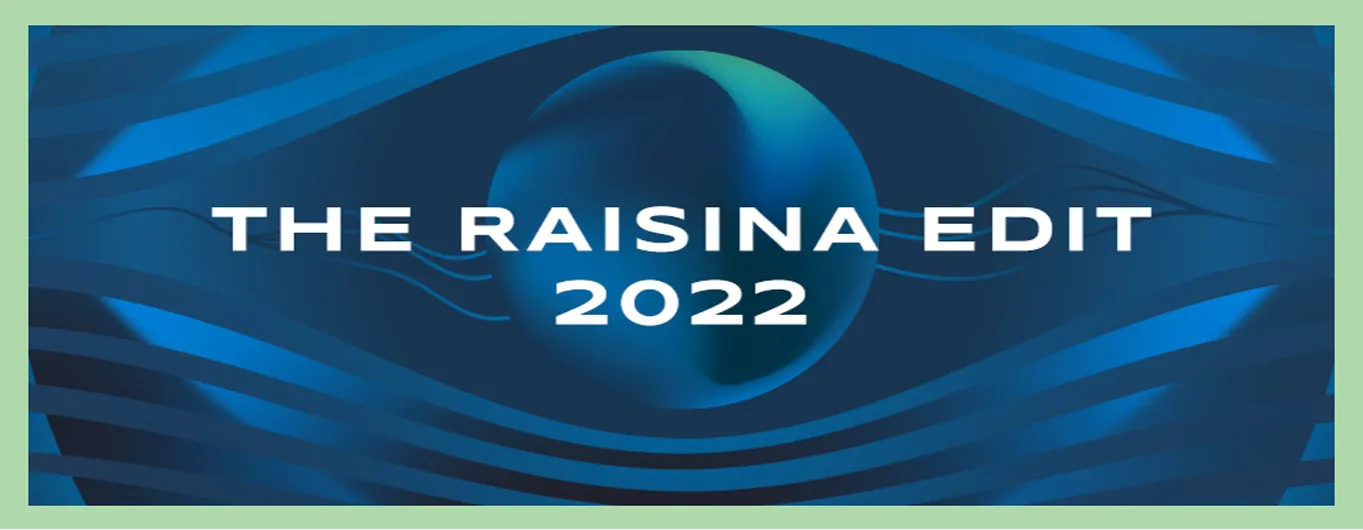 This article is part of the series—Raisina Edit 2022.
This article is part of the series—Raisina Edit 2022.
Financial technology has revolutionised the global financial sector and has, in many ways, fundamentally changed how we store, save, invest, transfer, and borrow money. Fintech, as it is now commonly known, may be regarded as a business application, process, or model, enabled by a combination of business, technological, and financial innovation.
Globally, a series of breakthroughs involving information and communication technologies (ICTs) have led to the continuous development and improvement of fintech. An observable pattern in fintech’s growth trajectory has been to begin by ensuring the accessibility of multiple services in the financial value chain, and then to design robust, secure systems that allow them to be used safely. The fintech sector continues to enjoy an extraordinarily high rate of growth across the
African region. This article briefly examines the role fintech is playing in Africa as an engine of economic growth and development, and an instrument for promoting financial inclusion.
An observable pattern in fintech’s growth trajectory has been to begin by ensuring the accessibility of multiple services in the financial value chain, and then to design robust, secure systems that allow them to be used safely.
Fintech in Africa
Mobile money has emerged as the
most popular and widely used financial technology in Africa, and is now used across almost 40 African countries. As of December 2020, nearly two-thirds of mobile money transactions were driven by users in Sub-Saharan Africa, with a total transaction value of almost
US$490 billion. East Africa, however, has continued to lead in terms of the adoption and use of financial technology. Among the principal
factors that have driven the growth of mobile money is the lack of banks and ATMs in the region, which has made it difficult and sometimes even impossible to transfer money and even pay bills.
East Africa has developed an innovative way to ensure smooth money transfers. The region favours a telecom-led regulatory model, where each country has one primary service provider—ensuring that the provider has a significant market share and is able to evolve a bouquet of services.
For instance, Safaricom is the largest provider in Kenya, while Vodacom enjoys the largest market share in Tanzania. This one-provider system has helped minimise compatibility and interoperability issues, and it is reinforced by national identification systems that enable secure transactions. Supported by these elements, fintech is being able to move beyond traditional payment systems, and promote not just financial inclusion, but also the advancement of other development sectors. On the whole though,
technical infrastructure in the African region needs to be strengthened: the availability of uninterrupted electricity continues to be a challenge at multiple locations, internet penetration is still relatively low, and high entry barriers to the telecom space have created highly concentrated industries. These issues have tended to impede the growth potential of ICT-enabled services.
M-Pesa’s access fee—which is levied on every payment, even on the company’s closed platforms—has become the most significant contributor to the companies' revenue.
The Case of M-Pesa: Kenya and Tanzania
M-Pesa is Kenya and Tanzania’s
most popular mobile-based money transfer system. Safaricom and Vodacom, Kenya and Tanzania’s major networks, both owned by Vodafone, started M-Pesa in 2007. The service enables customers to transfer, deposit, and withdraw money. Its services have now grown and expanded to other countries.
M-Pesa has approximately 28.3 million active users, and has close to 248,000 agents in Kenya. In March 2021, approximately
200 billion transactions flowed through M-Pesa, close to twice the Kenyan GDP.
M-Pesa has positively impacted the economies of Kenya and Tanzania. It has led to increasing per capita consumption levels, and has helped lift families out of poverty. It has also increased
financial resilience by enabling higher savings. M-Pesa’s
access fee—which is levied on every payment, even on the company’s closed platforms—has become the most significant contributor to the companies' revenue. M-Pesa also generates revenues from a loan product,
M-Shwari, launched in 2012;
lipa na M-Pesa for merchants to accept payments through M-Pesa; and an
overdraft facility called fuliza, launched in 2019, that allows customers to make transactions even when they have insufficient funds.
M-Pesa’s high success rate can thus be attributed, among other factors, to a high public demand due to insufficient local infrastructure in terms of banks and ATMs; a smart pricing strategy that attracts customers; and the “market fit” and inclusive design of M-Pesa’s services, arising from the company’s long working relationship with the central bank of Kenya.
Other African Fintech Services
Besides M-Pesa, numerous other fintech services have been developed across Africa. For instance,
Paga, created in 2009, is a digital bank that facilitates money transfers, bill payments, internet payments, and payroll solutions. It is primarily used in Nigeria, and has achieved extensive coverage in terms of customers. A UK-based digital money transfer service called
Simba Pay is operational in Ghana, Nigeria, Uganda, and Kenya. Through the Simba Pay app, one can transfer money via existing money wallet services; the adoption of the app is slowly gaining momentum in the countries where it is available.
Orange Money is a payment and withdrawal service in Côte d'Ivoire, Botswana, and Cameroon. It has developed a system of “mowali” (mobile wallet interoperability) through its cooperation with the MTN group, which facilitates interoperable payments across Africa.
Zoona is a mobile payments system that has been developed to expand its portfolio to the banking sector. It offers a service called “Sunga Pockets”, which helps customers access and store their money. Zoona has now partnered with an application called Kiva to offer financial and other means of support to local entrepreneurs. Similarly, a
Senegalese start-up called Wizall provides electronic payments to help customers with money transfer services in West Africa. And
Wizzit, a payments firm, has recently expanded into microfinance, also partnering with the World Bank to provide loans to small business users and help them expand their business.
Zoona has now partnered with an application called Kiva to offer financial and other means of support to local entrepreneurs. Similarly, a Senegalese start-up called Wizall provides electronic payments to help customers with money transfer services in West Africa.
As the above examples indicate, African fintech is in a state of constant growth, mirroring the increased growth of mobile penetration and use in the continent. It has also given rise to a large number of startups that have generated a wide range of new employment opportunities. The creation of startup hubs, in turn, has helped expand the African ecosystem for fintech services. Increasingly, fintech is beginning to have a positive impact on the growth of
Africa’s infrastructure and development sectors, such as health and agriculture. In a relatively recent development, a
new service called M-Kopa, in Kenya, is helping people in rural Kenya take digital loans that can then be used to acquire solar power connections. Fintech services are, thus, helping people to access and avail solar energy for their homes.
Conclusion
Fintech is making rapid strides as a sunrise sector in Africa. In 2021, the total capital invested in the sector grew by US$1.49 billion more than in the previous year, making it a
record year for funding in African fintech. The number of deals and average deal size have both shown steady growth. As a continent, Africa has the
youngest population worldwide, with around 40 percent of the population aged 15 years or younger. Global trends show that the uptake and adoption of fintech tends to be
significantly higher among millennials—hence, demographic factors may continue to be a key driver of the sector.
Moreover, Africa’s vast
underbanked population—estimated at 42 percent of the continent’s adult population or close to 460 million people in 2022—provides an untapped market for service providers who are able to offer alternative financial solutions and banking functions via mobile phones. Unsurprisingly, therefore, Africa had the
largest volume of mobile money transactions globally in 2020, at 374 percent more than South Asia, which is the second-largest market for mobile money. Given the value the young sector continues to generate, every effort must be made to develop enabling regulation, incubate fintech startups, and create fintech hubs across the continent that will attract talent, foster innovation, and catalyse economic growth.
The views expressed above belong to the author(s). ORF research and analyses now available on Telegram! Click here to access our curated content — blogs, longforms and interviews.



 This article is part of the series—
This article is part of the series— PREV
PREV


